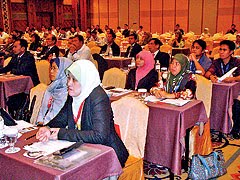The Permanent Secretary (Administration and Finance) at the Ministry of Development, Awg Hj Muhammad Lutfi bin Abdullah has underlined the fundamental importance of geospatial development in the role it plays in the development of the nation.
He was speaking at the opening session of the Basic Land Surveying Seminar Development (UTAP) based on the theme ‘Geospatial for Sustainable Development’ that was organised by the Survey Department and supported by the Brunei Institute of Geomantics (BIG), at the Rizqun International Hotel on Wednesday (14 November 2012).
The information extracted from the analytical information is a foundation for construction projects, and the relevance is high for those involved, such as stakeholders, in making decisions that are fast, accurate and effective, he further explained.
Awg Hj Muhammad Lutfi added that the technology utilised in the analysis has various aspects such as in environmental disasters, land usage, planning and others.
He added that the Survey Department has prepared geospatial information for nation-building purposes such as aerial photographs, LIDAR (Light Detection and Ranging), topographical maps and more.
The information, he said, has been compiled into the Survey Spatial Data Infrastructure (SSDI) launched the previous month and furthermore the Ministry of Development will integrate the information with other departments under the ministry before disseminating it to other government agencies. The completed system will be called the National Spatial Data Infrastructure.
Consequently, he urged all government agencies to work closely together in the sharing of geospatial information, such as disseminating the information to the general public and stakeholders through meaningful dialogues and discussions.
Earlier, the Acting Surveyor General of the Survey Department, Awg Hj Ali Bakar bin Hj Kasim said that nine working papers will be presented by the participants. He said that such information should be shared between relevant agencies for further utilisation according to needs, and underscored the importance to keep abreast with the latest technology.
The President of the International Federation of Surveyors (FIG), Mr Teo Chee Hai also said his organisation is focussed on ways to collaborate and to ensure that the disciplines of surveying meet the stated requirements. He further elaborated on the usage of geospatial information in devices such as geographical and temporal context.
The seminar was aimed at introducing new projects launched by the Survey Department, to identify projects in development by other government agencies, dissemination of geospatial information and the sharing of invaluable experiences amongst the participants.

Organised every two years, the UTAP seminar began in 1985 and this year’s session was held in conjunction with the Survey Department’s 60-year anniversary.
The seminar encompassed two sessions. The first session was entitled ‘Geospatial Readiness’ and was facilitated by Awg Newas bin Ukoi, while the second session was entitled ‘Geospatial Application’ and was facilitated by Pg Hj Matusin bin Pg Hj Matasan.
Source: Borneo Bulletin – 15 November 2012







